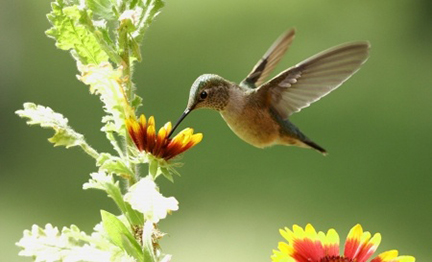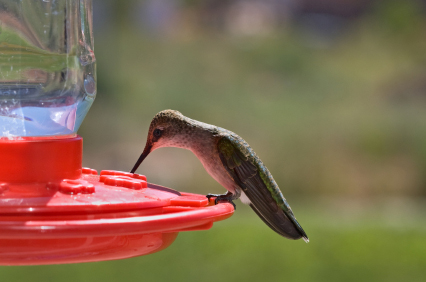How To Attract & Care For Nature’s Living Jewels!
Hummingbirds are exquisite adornments of New Mexico gardens, darting and hovering like mobile jewels, their wings a blur of motion. 17 or 18 different hummingbird species have been sighted in New Mexico at one time or another. Several major hummingbird migration routes run through our lucky state.
In fall and winter, most hummingbirds migrate to Central and South America. They start returning to Northern New Mexico by late March or early April, regardless of weather conditions.
Here’s how you can attract hummingbirds to your Northern New Mexico garden!
HOW TO ATTRACT HUMMERS
1. Put Up Hummingbird Feeders
With the destruction of natural habitats, wild birds are becoming increasingly dependent upon humans for the extra food they need to stay healthy and raise healthy young. Hummingbirds are no exception. So one of the best ways to attract hummers to the garden is to put up hummingbird liquid nectar feeders. If you have the room, put up more than one in different parts of your yard. Make sure your hummer feeders are positioned so that they are easily visible, and keep them away from your birdseed feeders. (Hummers don’t like having to push through crowds of the big birds on the block.)
Glass or plastic bottle-style feeders are the most common; flat saucer-style feeders are becoming increasingly popular. The feeders don’t have to be red, but hummingbirds are attracted to the color, says Anne Schmauss, owner of Wild Birds Unlimited in Santa Fe and co-author (with her sisters Mary Schmauss and Geni Krolick) of For The Birds: A Month-By-Month Guide to Attracting Birds To Your Backyard. Anne recommends tying a bit of red ribbon to nonred feeders to attract the birds’ attention.
She also recommends buying feeders with perches attached, so the hummers can sit while they drink. (Forcing a hummingbird to feed on the wing is like making yourself eat dinner while jogging!)
Packets of water-soluble hummingbird feeder nectar are available for purchase in most pet supply and garden stores. (Payne’s sells ‘em, too.) You can also feed hummingbirds nectar you make yourself from 1 part pure white or unbleached cane table sugar granules dissolved in 4 parts unchlorinated water. Superfine sugar, available in bakery sections of most supermarkets, costs a little more than regular granulated white sugar, but it is particularly easy to work with, as it dissolves almost instantly in warm water. Bring the sugar-water solution to a boil and let cool completely before filling the feeder with it.
Never substitute confectioner’s (powdered) sugar, honey, sorghum, molasses, agave, xylitol, or artificial sweeteners for the table sugar. These sweeteners are not digestible by hummingbirds and can harm them.
Every 3 days, bring your nectar feeders indoors, empty them, and wash them in hot soapy water. This gets rid of potentially harmful molds and bacteria that could make your visitors sick. Rinse the feeders thoroughly before you refill them with nectar.
Don’t worry too much if you find little insects are attracted to your hummingbird feeders, too. Small insects make up a large part of a hummingbird’s diet. If ants are a problem, purchase an ant guard for your feeder (available at Payne’s).
2. Plant Hummingbird Flowers
There are lots of shrubs, vines, perennials, and annuals that do well in Northern New Mexico, and can provide delicious natural nectar for your hummingbird buddies. Here are a few we recommend!
Annuals & Biennials: balsam, cardinal climber, cleome, foxglove, four o’clocks, hollyhock, larkspur, morning glory, nasturtium, petunia, ‘Lady In Red’ sage, scarlet gilia, standing cypress, scarlet runner bean, flowering tobacco, sweet William
Bulbs, Rhizomes & Tubers: canna, crocosmia, freesia, gladiolus, iris, lily
Houseplants (placed outside in summer): begonia, cestrum, citrus, common geranium, fuschia, hibiscus, impatiens, jasmine, lantana, pineapple sage, shrimp plant, verbena
Perennials: agastache (aka hummingbird mint), beebalm, cardinal flower, columbine, coral bells, daylily, delphinium, dianthus, kniphofia, lupine, mallow, obedient plant, periwinkle, phlox, silene, soapwort, yucca
Shrubs & Hardy Vines: butterfly bush (Buddleja), hawthorn (Crataegus), honeysuckle (Lonicera), lilac (Syringa vulgaris), rose of Sharon (Hibiscus syriacus), trumpet vine (Campsis radicans)
For Further Enjoyment
Hummingbirds of New Mexico (http://www.hbnm.org) is a non-profit organization based in Silver City that is dedicated to the study and preservation of hummingbirds in the State of New Mexico. Founded by amateur ornithologist Joan E. Day-Martin, HBNM is a great source of information on hummers, particularly for those in the southern half of the state. You may write the group at HBNM, HC 68 Box 169, Silver City NM 88061-9311 or email them care of hbnm@gilanet.com.
For the Birds:A Month-By-Month Guide To Attracting Birds To Your Backyard by Anne and Mary Schmauss and Geni Krolick (New York: Stewart Tabori & Chang, 2008, ISBN 978-1-58479-717-3, softcover, 224 pp). This oversized, richly photoillustrated softcover is one of the most comprehensive, practical, and accessible handbooks to backyard birdculture you’ll find anywhere.
Lots of info on hummers!


